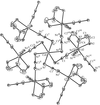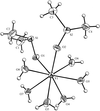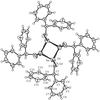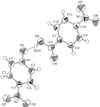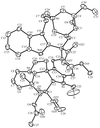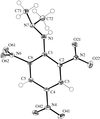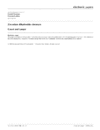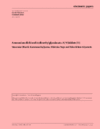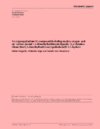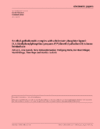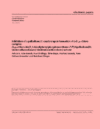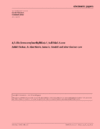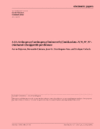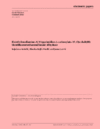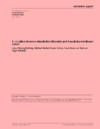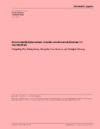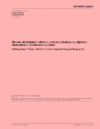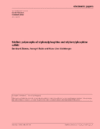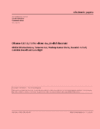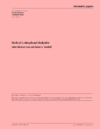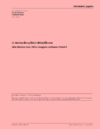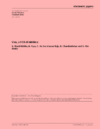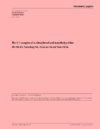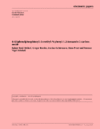issue contents
February 2000 issue

Cover illustration: The structure of the [Y(H2O)6{(CH3)2SO}2]3+ cation with displacement ellipsoids drawn at the 30% probability level. See Kristiansson and Lindqvist-Reis [Acta Cryst. C56, 163-164].
inorganic compounds
Download citation


Download citation


Hg(PO3)2 is isotypic with the low-temperature form α-Cd(PO3)2. It contains infinite polyphosphate chains and 1∞[HgO2O4/2] units, both running parallel to the c axis.
Download citation


Download citation


The title compound crystallizes with the Na4CoO4 structure type, showing discrete SnO44− anions as main building blocks. The structure is thus isotypic with a series of corresponding compounds A4MO4 (A = alkali metal and M = group IV element).
Download citation


Download citation


The high-temperature structure of lanthanum diarsenide comprises La3+ cations coordinated in a tricapped trigonal prismatic geometry by As atoms from two kinds of polyarsenide chain anions, namely As35− and As57−.
metal-organic compounds
Download citation


Download citation


Download citation


Download citation


Download citation


Download citation


Download citation


Download citation


Download citation


Download citation


Download citation


Download citation


Download citation


Download citation


Download citation


Download citation


Download citation


Download citation


Download citation


Download citation


Download citation


Download citation


Download citation


Download citation


Download citation


Download citation


Download citation


Download citation


Download citation


Download citation


In the title compound, decasodium diglycine dihydrogenodotetracontadodecatungstate(10−) octacosahydrate, the two glycine carboxylate O atoms coordinate three different Na+ cations, while the amino N atom forms hydrogen bonds with the paratungstate anion through both terminal and bridging O atoms.
Download citation


Download citation


Download citation


Download citation


Download citation


Download citation


Download citation


Download citation


organic compounds
Download citation


Download citation


Download citation


Download citation


Download citation


Download citation


Download citation


Download citation


Download citation


Download citation


Download citation


Download citation


Download citation


Download citation


Download citation


Download citation


Download citation


Download citation


Download citation


Download citation


Download citation


Download citation


Download citation


Download citation


Download citation


Download citation


Download citation


Download citation


Download citation


Download citation


Download citation


Download citation


Download citation


Download citation


Download citation


Download citation


Download citation


Download citation


Download citation


Download citation


Download citation


Download citation


Download citation


Download citation


Download citation


Download citation


Download citation


Download citation


Download citation


Download citation


Download citation


Download citation


Download citation


Download citation


Download citation


Download citation


Download citation


Download citation


Download citation


Download citation


electronic papers (inorganic compounds)
Download citation


Download citation


The 0D structure of Zr(OH)2CrO4 has been reinvestigated [Mark (1972). Acta Chem. Scand. 26, 3744–3756]. It consists of infinite nets with the composition [Zr3(OH)6CrO4]n4n+, joined together by chromate groups; the zirconium polyhedra are not influencead by the 0D phenomenon.
electronic papers (metal-organic compounds)
Download citation


Download citation


In the title compound, the Ir atom is octahedrally coordinated by two trans Cl− and two dimethylglyoximate chelate ligands in the equatorial plane. A two-dimensional hydrogen-bond network between NH4+ and [IrCl2(C4H7N2O2)2]− is extended along the bc plane.
Download citation


Download citation


In the title compound, the Pd atom is coordinated by two 1,3-dimethylbarbiturate anions, one through a deprotonated tetrahedral C atom and the other through the enolate O atom.
Download citation


Download citation


In the title dimethylpalladium(II) complex, [Pd(CH3)2(C27H26P2)]·0.5C7H8, the P—Pd—P angle [93.18 (3)°] is significantly larger than that in the corresponding dichloro complex [89.32 (3)°]. The toluene molecule is disordered around an inversion centre.
Download citation


Download citation


The title compound contains a centrosymmetric dimeric cation and it is formed upon slow evaporation of a solution containing bis(acetonitrile)bis[1,2-bis(diphenylphosphino)ethane]palladium(II) bis(tetrafluoroborate) in deuterated chloroform. The anion and the solvent molecule are slightly disordered.
Download citation


Download citation


In (C5H5FeC5H5)2(C5H4OS4), the values of the geometric parameters of the ferrocene and 1,3-dithiol-2-one (dmio) moieties are within normal ranges.
Download citation


Download citation


All three independent molecules in the triclinic modification of (O-isopropyl dithiocarbonato-S)triphenyltin show tetrahedral coordination at their Sn atoms. Bond dimensions involving the Sn atoms are similar to those found in the monoclinic modification of the same compound. Two of the independent molecules are related by a pseudo-translation allowing a stacking fault that reduces the intensities of h + k odd reflections.
Download citation


Download citation


In the title compound, four N atoms from the deprotonated ligand derived from bis(3-aminopropyl)amine and 2-imidazolecarboxaldehyde are coordinated to the Cu atom. The methanol O atom occupies one axial position with a Cu—O bond distance of 2.295 (2) Å.
Download citation


Download citation


In the title compound, the coordination geometry of the CoIII atom is only slightly distorted from regular octahedral, and the racemic nature of the material was confirmed by X-ray structure analysis.
Download citation


Download citation


The tin coordination in dibromodimethyl(N-methylpyrrolidin-2-one-O)tin(IV) is a distorted trigonal bipyramid with the methyl groups and one bromine in equatorial, and the N-methylpyrrolidinone (NMP) ligand and the other bromine in apical positions. The Sn—Br bond lengths are 2.6737 (4) and 2.5256 (4) Å.
Download citation


Download citation


The six Mo atoms of the title compound form a standard octahedral cage through bridging O atoms. The [Mo6O19]2− anions as a whole have exact Oh symmetry with three crystallographic fourfold axes aligned along Mo—O—Mo.
electronic papers (organic compounds)
Download citation


Download citation


The crystal structure contains two independent molecules with slightly different conformations; these are linked to form a two-dimensional network by pairs of O—H⋯O and N—H⋯O hydrogen bonds.
Download citation


Download citation


New triclinic polymorphs of triphenylphosphine, C18H15P, (I>), and triphenylphosphine sulfide, C18H15PS, (II>), were crystallized. For the structure of (I>), it is obvious that the highest peaks in the final difference electron-density map are located at the `lone-pair regions' of P atoms. We have observed this effect in two further phosphorous-containing structures.
Download citation


Download citation


The title compound is a triterpene isolated from the leaves of the plant Jacquinia Ruscifolia, found in Mexico. The absolute structure could not be established unambiguously. The saturated rings are all in chair conformations, while the unsaturated rings are half chairs.
Download citation


Download citation


Dodecyl 2-nitrophenyl disulphide contains an intramolecular S⋯O contact of 2.623 (3) Å. The angle between the planes of the NO2 group and the attached phenyl ring is 4.2 (3)°.
Download citation


Download citation


In the five-membered ring in the title compound, the dimensions at the B atom are N—B 1.654 (3), O—B 1.479 (3), and C—B 1.606 (3) and 1.609 (3) Å.
Download citation


Download citation


The crystal structure of the title compound, derived from an ultrathin plate-shaped specimen, is divided into hydrophobic and hydrophilic layers. Two peptide molecules in the asymmetric unit are related by pseudo-translation, but two of the four 2-propanol molecules have different relative orientations and hydrogen-bond interactions.
Download citation


Download citation


The title compound has a centrosymmetric dication, which is hydrogen bonded to the anions with an N⋯Cl distance of 3.012 (3) Å.
Download citation


Download citation


Viox {2,5-dihydro-4-[4-(methylsulfonyl)phenyl]-3-phenyl-2-furanone} is a selective COX-II inhibitor with anti-arthritic activity. Although the molecule itself is achiral, it crystallizes in a chiral space group and the absolute structure has been reliably determined.
Download citation


Download citation


4-Nitrophenol and 4-methylpyridine are linked by an O—H⋯O hydrogen bond [O⋯N 2.668 (2) Å]. These dimers pack in a herring-bone pattern in the crystal lattice.
Download citation


Download citation


The regio- and stereochemistry of the title compound has been established by X-ray analysis. The molecular dimensions are normal.
Download citation


Download citation


The title compound, a phosphorus-substituted isoxazole ring, was prepared by a 1,3-dipolar cycloaddition. The molecular structure is stabilized by an intramolecular N—H⋯O hydrogen bond.


 journal menu
journal menu
















